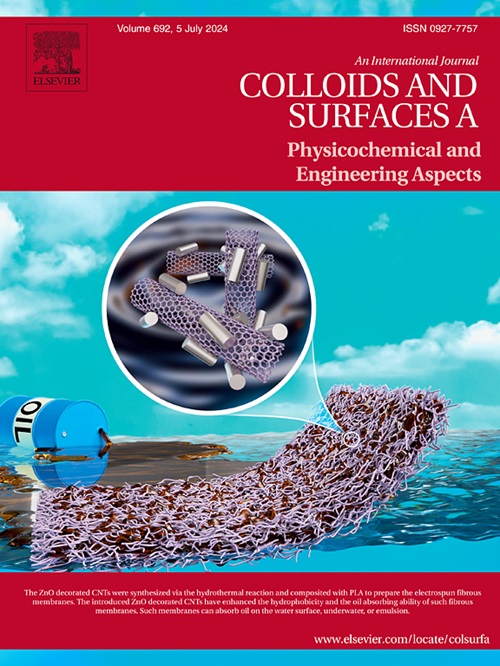Assessment of three quinolin-8-ol-imidazole hybrids as corrosion carbon steel inhibitors in acidic conditions employing practical and theoretical methodologies
IF 4.9
2区 化学
Q2 CHEMISTRY, PHYSICAL
Colloids and Surfaces A: Physicochemical and Engineering Aspects
Pub Date : 2024-11-06
DOI:10.1016/j.colsurfa.2024.135690
引用次数: 0
Abstract
Three hybrids of quinolin-8-ol-imidazole were scrutinized as corrosion inhibitors in 1 M HCl for carbon steel (Cstl). These hybrids are 5-((2-(4-(dimethylamino)phenyl)-4,5-diphenyl-1H-imidazol-1-yl)methyl)quinoline-8-ol (Quin-Amino), 5-((4,5-diphenyl-2-(p-tolyl)-1H-imidazol-1-yl)methyl)quinoline-8-ol (Quin-Tolyl), and 5-((2-(4-bromophenyl)-4,5-diphenyl-1H-imidazol-1-yl)methyl)quinoline-8-ol (Quin-Br). The current research includes a mixture of methods. In addition to computational approaches, several experimental approaches were employed, such as electrochemical impedance spectroscopy (EIS), scanning electron microscopy (SEM-EDX), UV–vis spectroscopy, and potentiodynamic polarization (PDP). The investigated hybrids' corrosion resistance was encountered to be concerned by the concentration, temperature, and chemical structure, which attained a maximum of 96.1 % for Quin-Amino, 93.4 % for Quin-Tolyl, and 92.5 % for Quin-Br at 10−3 M, respectively. The PDP results illustrated that the studied hybrids performed as mixed-type inhibitors. In addition, the chemisorption of these hybrids on the Cstl surface obeyed the Langmuir adsorption isotherm. SEM-EDX confirmed that the effectiveness of the three hybrids lies in their capability to develop an organic layer on the Cstl surface. The density functional theory (DFT) was employed for theoretical calculations. Molecular dynamics (MD) simulations manifest that hybrids are oriented beneficially on the Fe (110) surface, providing a high surface coverage and thus a high inhibition performance.
利用实践和理论方法评估三种喹啉-8-醇咪唑杂化物作为酸性条件下碳钢缓蚀剂的性能
研究了三种喹啉-8-醇咪唑混合物,作为碳钢(Cstl)在 1 M HCl 中的缓蚀剂。这些混合物是 5-((2-(4-(二甲基氨基)苯基)-4,5-二苯基-1H-咪唑-1-基)甲基)喹啉-8-醇(Quin-Amino)、5-((4、5-((4,5-二苯基-2-(对甲苯基)-1H-咪唑-1-基)甲基)喹啉-8-醇(Quin-Tolyl)和 5-((2-(4-溴苯基)-4,5-二苯基-1H-咪唑-1-基)甲基)喹啉-8-醇(Quin-Br)。目前的研究包括多种方法。除计算方法外,还采用了多种实验方法,如电化学阻抗光谱法(EIS)、扫描电子显微镜法(SEM-EDX)、紫外可见光谱法和电位极化法(PDP)。结果表明,所研究的杂化物的耐腐蚀性与浓度、温度和化学结构有关,在 10-3 M 时,Quin-Amino、Quin-Tolyl 和 Quin-Br 的耐腐蚀性分别达到 96.1%、93.4% 和 92.5%。PDP 结果表明,所研究的混合物具有混合型抑制剂的性能。此外,这些杂化物在 Cstl 表面的化学吸附符合 Langmuir 吸附等温线。扫描电子显微镜(SEM-EDX)证实,这三种混合物的功效在于它们能在 Cstl 表面形成有机层。理论计算采用了密度泛函理论(DFT)。分子动力学(MD)模拟结果表明,混合物在铁(110)表面具有良好的定向性,提供了高表面覆盖率,因此具有很高的抑制性能。
本文章由计算机程序翻译,如有差异,请以英文原文为准。
求助全文
约1分钟内获得全文
求助全文
来源期刊
CiteScore
8.70
自引率
9.60%
发文量
2421
审稿时长
56 days
期刊介绍:
Colloids and Surfaces A: Physicochemical and Engineering Aspects is an international journal devoted to the science underlying applications of colloids and interfacial phenomena.
The journal aims at publishing high quality research papers featuring new materials or new insights into the role of colloid and interface science in (for example) food, energy, minerals processing, pharmaceuticals or the environment.

 求助内容:
求助内容: 应助结果提醒方式:
应助结果提醒方式:


